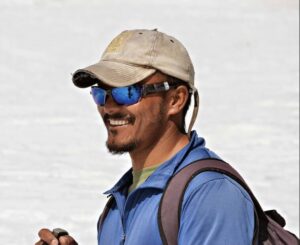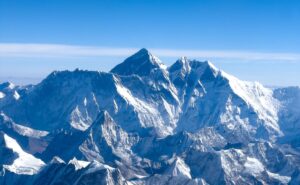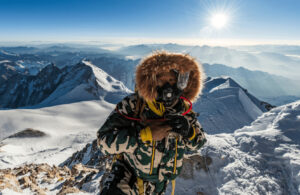On Annapurna, a small group of climbers has pulled off a seemingly impossible task. After three days, when hope was all but abandoned, they found Indian climber Anurag Maloo inside a crevasse. Then they rescued him — barely breathing but alive — from a spot on the mountain dangerously exposed to avalanches.
Adam Bielecki of Poland again abandoned his own expedition to help others, as he did in winter 2018 on Nanga Parbat, when he helped save Elisabeth Revol.
This time, his climbing partner Mariusz Hatala, plus Lakpa Nurbu Sherpa, Chhepal Sherpa, Dawa Nurbu Sherpa, Lakpa Sherpa, and Tashi Sherpa — coordinated from Base Camp by Chhang Dawa Sherpa of Seven Summit Treks — put together the improbable rescue. Bielecki, Hatala (and possibly a third person) rappelled into the crevasse where Maloo had fallen three days earlier. There, they extracted him from where he lay, barely showing any sign of life.

File image of Anurag Maloo.
Against all odds
“I thought I was looking for a body in that crevasse, [which was] 50 meters deep,” Bielecki told his home team. “Then I realized that he was alive.”
The helicopter pilots performed equally remarkable work. Flying the unconscious Maloo back to Kathmandu was not an option because of bad weather. Instead, they successfully airlifted him to Pokhara’s Manipal Hospital. Later that day, they transferred him to Medicity Hospital in Kathmandu, where he remains in very serious condition.

The crevasse where Anurag Maloo fell. Photo: @moesesfiamoncini
“This was a one-in-a-million rescue,” Mingma Sherpa of Seven Summit Treks declared. He noted that Maloo was “250m below,” but he possibly meant the distance down the slope and the crevasse, from the belay point where the rescuers rappelled. The video he shared speaks for itself:
Asked by Explorersweb what was the operation like, Chhepal Sherpa, one of the rescuers and a recent winter Manaslu summiter, simply said: “Scary”.
The team was very aware of the constant avalanches, including the major slide that swept the route between Camp 3 and Camp 2 two weeks earlier. At that time, it was just luck that no one was buried. “Luckily, there was no avalanche this time,” Chhepal Sherpa said.
Everything happened very fast. Bielecki and Hatala were waiting for Felix Berg — who summited Manaslu on Monday — to join them on a new route they intend to open alpine-style on Annapurna’s NW Face. When asked to help, they didn’t hesitate.
After the rescue, the Poles returned to their Base Camp tents. They will now have to wait out the patch of stormy weather before continuing with their own project.

The rescue team at Annapurna Base Camp. Standing at left, Adam Bielecki and Mariusz Hatala flank helicopter pilot Sobit Gauchan. Chhepal Sherpa is in the middle of the front row. Photo: Courtesy of Chhepal Sherpa/Sobit Gauchan
Maloo’s state
The Indian climber’s extraction from the crevasse was only the first miracle today. He was also lucky to be airlifted — by expert rescue pilot Sobit Gauchan — to the hospital in Pokhara, despite bad weather. There, Dr. Asim Subedi performed CPR on him for hours to keep his heart beating and his lungs functioning.
A helicopter (piloted by Subash Khadka) then transferred Maloo to the hospital in Kathmandu. He is currently in a coma in the ICU, connected to a ventilator, and in critical condition. Yet doctors see a “ray of hope,” since the patient is “trying to move his body and making efforts to take spontaneous breaths,” The Himalayan Times reported.
Eyewitness account of the accident
Anurag Maloo fell in a crevasse on April 17. He had previously decided to attempt Annapurna, his first 8,000’er, without oxygen. According to several climbers on the mountain, Maloo made the decision after learning Baljeet Kaur was climbing that way.
Maloo started his summit push the night before. At some point during his climb, he felt sick and turned around, together with his Sherpa.
On April 15, Moeses Fiamoncini of Brazil had also turned around on his own no-O2 attempt — his third try on Annapurna – just 70 meters below the summit. He had remained in Camp 3, hoping to launch another attempt, but finally discarded the idea. He went down at the same time Maloo did and witnessed the accident.
“Maloo was very weak, probably with some AMS, so I descended all the time some meters behind or in front of him, and so did his Sherpa. He was never alone,” Fiamoncini told ExplorersWeb.
The climbers eventually reached a vertical section requiring an eight-meter rappel. “Maloo asked me to go in front of him;” Fiamoncini recalls. “There were three ropes. I checked one, made sure it was okay, and rappelled. When I finished, I looked up and saw, to my horror, that Maloo was rappelling on a very short rope, only a couple of meters long.

The cut rope that Maloo used, circled in orange, beside another, longer rope that reached the end of the rappel. Photo: @moesesfiamoncini
Rappelled down a broken rope
“I shouted to him, telling him to stop, to look at the rope, but he didn’t. He fell when the rope ended, and he hit the hard ice one meter to the right of me and immediately slid down, rolling, for some more meters until he disappeared in the crevasse. I was horrified.”

The red line shows where Maloo rappelled, hit the ice, and then rolled into the crevasse, unconscious. Photo: @moesesfiamoncini
“I yelled, calling his name. His Sherpa took a rope and approached the edge of the crevasse, looking and calling him. We took a lot of risks remaining there, in a section completely exposed to avalanches, and avalanches fell constantly. We remained there for a long time, calling him. But he never made a sound, not even when falling. In such circumstances, I knew the possibility of finding Anurag alive was really very slim. We continued to Base Camp in shock.”
The video above shows the moments after Maloo fell into the crevasse. Fiamoncini’s voice explains what just happened. Video: @moesesfiamoncini. Warning: Sensitive content.
“The following morning, I boarded a helicopter in order to search the area, since I knew exactly where Maloo had fallen. We saw nothing.”
The videos show footage during the helicopter search for Anurag Maloo on the morning of April 18. Videos: @moesesfiamoncini
Fiamoncini was also devastated by the sad news about Noel Hanna’s passing in Camp 4.
“My climbing partners — Sergi Mingote and Juan Pablo Mohr — died on K2… it’s just too many friends gone,” he said.
Fiamoncini had planned to head for Dhaulagiriafter Annapurna, but at the moment he is pondering his options. Today, he flew to Kathmandu with Hanna’s widow.

Happier moments: Left to right, Moeses Fiamoncini, Sajid Sadpara, and Noel Hanna. Photo: Moeses Fiamoncini
Rescue efforts
Maloo’s outfitter, Seven Summit Treks, dispatched men on foot to look around the crevasse. The missing climber’s family also flew into action. They traveled to Kathmandu, asked for help from both the Nepalese and Indian governments, and started a petition on Instagram. The Indian embassy and Nepal Army supported the operation too.
The insurance company dispatched the team that pulled off the miracle. The Nepali and Polish climbers carried 300 meters of rope, some technical equipment, an infrared camera, metal detectors, and Recco sensors. This morning, all those efforts paid off.






